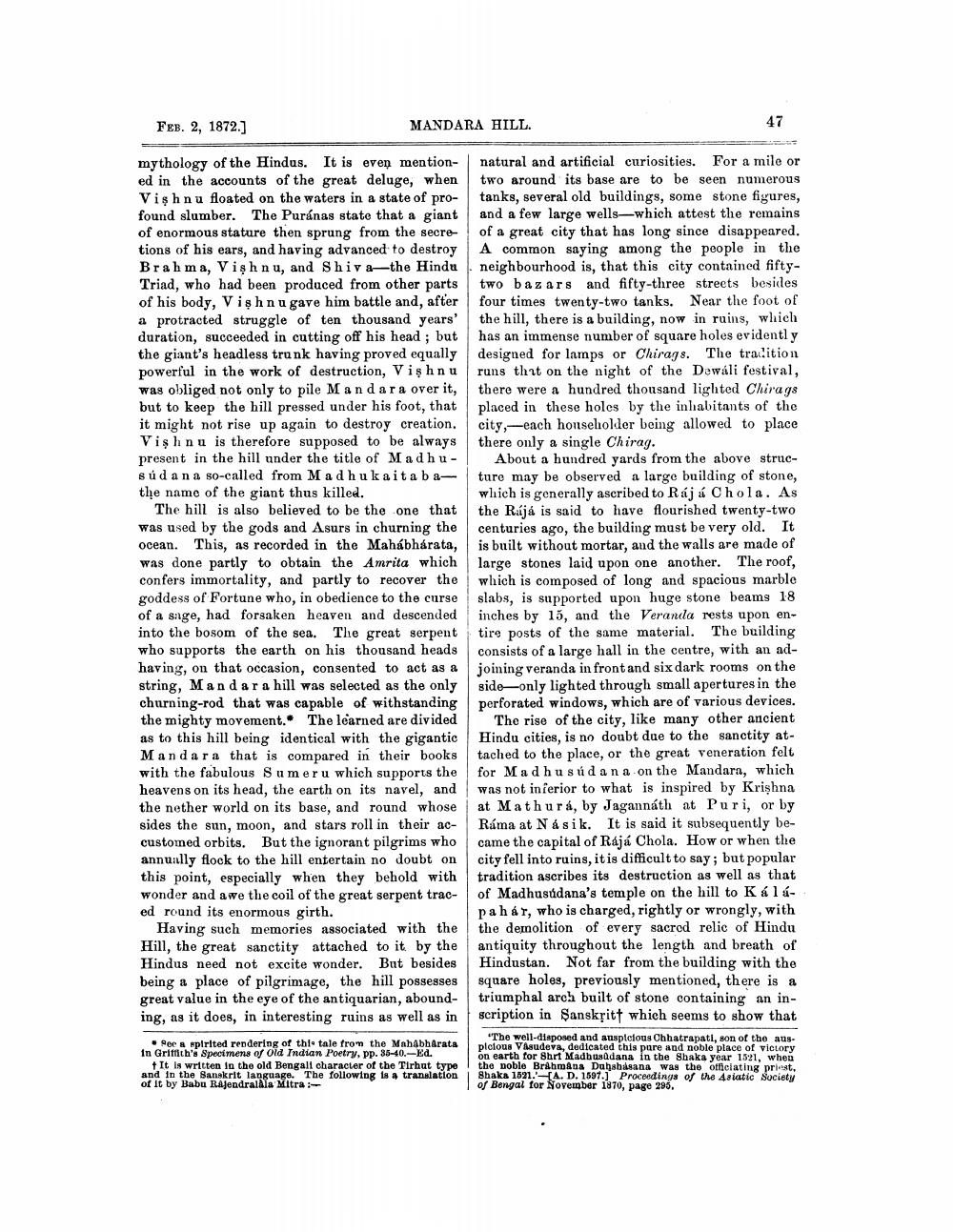________________
FEB. 2, 1872.]
MANDARA HILL.
47
mythology of the Hindus. It is even mention- natural and artificial curiosities. For a mile or ed in the accounts of the great deluge, when two around its base are to be seen numerous Vishnu floated on the waters in a state of pro- tanks, several old buildings, some stone figures, found slumber. The Puranas state that a giant and a few large wells—which attest the remains of enormous stature then sprung from the secre of a great city that has long since disappeared. tions of his ears, and having advanced to destroy A common saying among the people in the Brahma, Vishnu, and Shiva—the Hindu neighbourhood is, that this city contained fiftyTriad, who had been produced from other parts two bazars and fifty-three streets besides of his body, Vishnu gave him battle and, after four times twenty-two tanks. Near the foot of a protracted struggle of ten thousand years' || the hill, there is a building, now in ruins, which duration, succeeded in cutting off his head; but has an immense number of square holes evidently the giant's headless trunk having proved equally designed for lamps or Chirage. The tradition powerful in the work of destruction, Vishnu runs that on the night of the Dowali festival, was obliged not only to pile Mandara over it, there were a hundred thousand lighted Chirags but to keep the hill pressed under his foot, that placed in these holes by the inhabitants of the it might not rise up again to destroy creation. city,-each householder being allowed to place Vishnu is therefore supposed to be always there only a single Chirag. present in the hill under the title of Madhu - About a hundred yards from the above strucsúd a na so-called from Madhuk aita ba- ture may be observed a large building of stone, the name of the giant thus killed.
which is generally ascribed to Ráj á Chola. As The hill is also believed to be the one that the Rújá is said to have flourished twenty-two was used by the gods and Asurs in churning the centuries ago, the building must be very old. It ocean. This, as recorded in the Mahábhárata, is built without mortar, and the walls are made of was done partly to obtain the Amrita which large stones laid upon one another. The roof, confers immortality, and partly to recover the which is composed of long and spacious marble goddess of Fortune who, in obedience to the curse slabs, is supported upon huge stone beams 18 of a sage, had forsaken heaven and descended inches by 15, and the Veranda rests upon eninto the bosom of the sea. The great serpent tire posts of the same material. The building who supports the earth on his thousand heads consists of a large hall in the centre, with an adhaving, on that occasion, consented to act as a joining veranda in front and six dark rooms on the string, Mandar a hill was selected as the only side-only lighted through small apertures in the churning-rod that was capable of withstanding perforated windows, which are of various devices. the mighty movement.* The learned are divided The rise of the city, like many other ancient as to this hill being identical with the gigantic Hindu cities, is no doubt due to the sanctity atMandara that is compared in their books tached to the place, or the great veneration felt with the fabulous Sumeru which supports the for Madhu s údana on the Mandarn, which heavens on its head, the earth on its navel, and was not inferior to what is inspired by Krishna the nether world on its base, and round whose at Mathur á, by Jagannath at Puri, or by sides the sun, moon, and stars roll in their ac- Ráma at Násik. It is said it subsequently becustomed orbits. But the ignorant pilgrims who came the capital of Raja Chola. How or when the annunlly flock to the hill entertain no doubt on city fell into ruins, it is difficult to say; but popular this point, especially when they behold with tradition ascribes its destruction as well as that wonder and awe the coil of the great serpent trac- of Madhusudana's temple on the hill to Káláed round its enormous girth.
pahár, who is charged, rightly or wrongly, with Having such memories associated with the the demolition of every sacred relic of Hindu Hill, the great sanctity attached to it by the antiquity throughout the length and breath of Hindus need not excite wonder. But besides Hindustan. Not far from the building with the being a place of pilgrimage, the hill possesses square holes, previously mentioned, there is a great value in the eye of the antiquarian, abound- triumphal arch built of stone containing an ining, as it does, in interesting ruins as well as in scription in Sanskritt which seems to show that fee a spirited rendering of thi. tale from the Mahabharata
"The well-disposed and auspicious Chhatrapati, son of the aus. in Griffith's Specimens of Old Indian Poetry, pp. 35-40.-Ed.
plotous Vasudeva, dedicated this pure and noble place of victory
on earth for Shrt Madhusudana in the Shaka year 1521, when It is written in the old Bengali character of the Tirhut type the poble Brahmaua Dahshasana was the officiating prist, and in the Sanskrit language. The following is a translation Shaka 1621. A.D. 1591.) Proceedings of the 4siatic Society of it by Babu R&Jendral la Mitra
of Bengal for November 1870, page 295.




